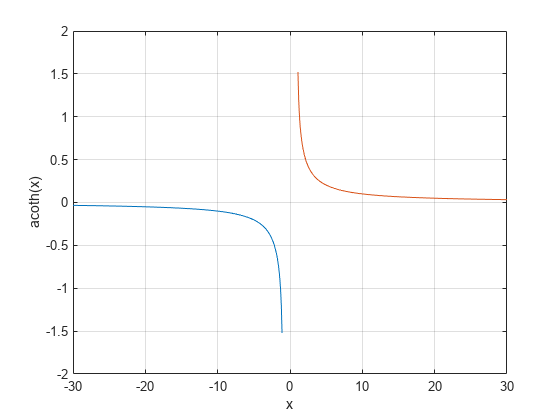acoth
反双曲余切
说明
示例
输入参数
角的双曲余切,指定为标量、向量、矩阵、多维数组、表或时间表。如果 X 为非标量,则按元素执行 acoth 运算。
数据类型: single | double | table | timetable
复数支持: 是
详细信息
对于域 和 中的实数值 ,反双曲余切满足
对于复数 以及域 中的实数值,调用 acoth(z) 将返回复数结果。
扩展功能
acoth 函数完全支持 tall 数组。有关详细信息,请参阅 tall 数组。
C/C++ 代码生成
使用 MATLAB® Coder™ 生成 C 代码和 C++ 代码。
此函数完全支持基于线程的环境。有关详细信息,请参阅在基于线程的环境中运行 MATLAB 函数。
acoth 函数支持 GPU 数组输入,但有以下用法说明和限制:
如果在 GPU 上运行的函数的输出可能为复数,则必须将其输入参量显式指定为复数。有关详细信息,请参阅在 GPU 上处理复数 (Parallel Computing Toolbox)。
有关详细信息,请参阅在 GPU 上运行 MATLAB 函数 (Parallel Computing Toolbox)。
此函数完全支持分布式数组。有关详细信息,请参阅使用分布式数组运行 MATLAB 函数 (Parallel Computing Toolbox)。
版本历史记录
在 R2006a 之前推出acoth 函数可以对表或时间表中的所有变量执行计算,而无需通过索引访问这些变量。所有变量都必须具有支持计算的数据类型。有关详细信息,请参阅Direct Calculations on Tables and Timetables。
MATLAB Command
You clicked a link that corresponds to this MATLAB command:
Run the command by entering it in the MATLAB Command Window. Web browsers do not support MATLAB commands.
选择网站
选择网站以获取翻译的可用内容,以及查看当地活动和优惠。根据您的位置,我们建议您选择:。
您也可以从以下列表中选择网站:
如何获得最佳网站性能
选择中国网站(中文或英文)以获得最佳网站性能。其他 MathWorks 国家/地区网站并未针对您所在位置的访问进行优化。
美洲
- América Latina (Español)
- Canada (English)
- United States (English)
欧洲
- Belgium (English)
- Denmark (English)
- Deutschland (Deutsch)
- España (Español)
- Finland (English)
- France (Français)
- Ireland (English)
- Italia (Italiano)
- Luxembourg (English)
- Netherlands (English)
- Norway (English)
- Österreich (Deutsch)
- Portugal (English)
- Sweden (English)
- Switzerland
- United Kingdom (English)
